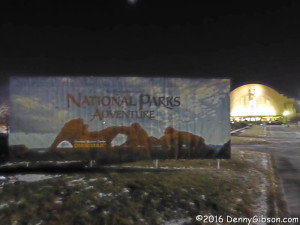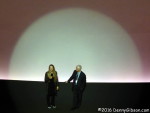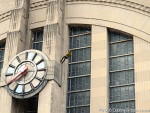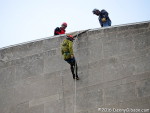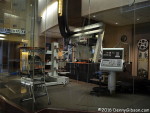I have never seen a movie quite like this before. It is classified as a documentary, and it documents a war that is going on at this very minute. As I took my seat in the empty theater, I found myself thinking of the newsreels that were still sometimes shown in front of feature films when I was a kid. Those thoughts weren’t entirely off base even though the upcoming scenes were shot a couple of years ago. Those scenes are not staged. The people in them are not actors. But Porcelain War is a whole lot more than a newsreel. Yes, it shows us near-current events but it also shows us people — artistic, talented, and determined people.
The three stars of the movie are identified as “participants”. One, Slava Leontyev, is also identified as a co-director. Another, Andrey Stefanov, is the movie’s primary cinematographer, a task he undertook for the first time. The third, Anya Stasenko, is also the movie’s Associate Producer. All three are artists who chose to remain in Ukraine to make art as a form of resistance to the 2022 Russian Invasion in addition to more conventional forms of resistance.
The porcelain of the title refers to the small ceramic sculptures that husband and wife Slava and Anya produce. Slava creates the plain white figures that Anya paints. There are scenes of creative sculpting and painting, and there are scenes where the figures serve as decoration or as a member of the cast. There are scenes where the little pieces of art are literally the only bright spot in a screen filled with the devastation of war. They are ever-present reminders of the fight against the destruction of a culture by destroying its art.
The two co-directors’ first in-person meeting was at the film’s premier at the Sundance Film Festival. Their separation by distance and language makes the results of their collaboration even more impressive. Andrey’s “training” by Bellomo’s stateside team had the same issues but also overcame them with quite obvious success.
Two other teams made major contributions to the movie. One is Poland’s BluBlu Studios which created 7,000 hand-drawn frames to animate some of Anya’s artwork in one of the most seamless blendings of media I’ve ever seen. The second is the band DakhaBrakha whose music seems to fit perfectly. The band does not appear in the body of the film but can be seen performing behind the end credits.
 It looks like tomorrow (Jan 9) is the last day Mariemont Theater is showing Porcelain War. I know that the recent snow might make that a tough trip even if you are attracted to the movie. That’s a bummer but the movie is worth braving some snow if you’re close enough or watching for showings elsewhere and on other dates if you’re not.
It looks like tomorrow (Jan 9) is the last day Mariemont Theater is showing Porcelain War. I know that the recent snow might make that a tough trip even if you are attracted to the movie. That’s a bummer but the movie is worth braving some snow if you’re close enough or watching for showings elsewhere and on other dates if you’re not.

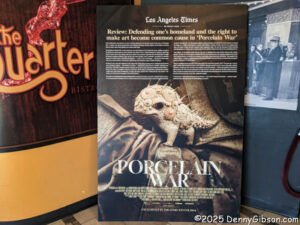

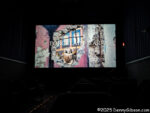
 I have not followed every detail of the astounding James Webb Space Telescope’s beginnings but I have been aware of some of the bigger events. I knew when it left Earth atop an Ariane 5 rocket on December 25, 2021, and I listened to reports of its eighteen gold-coated mirrors being unfolded and aligned. I marveled at those first images shared with the world on July 12, 2022. They were impressive on the tiny 6-inch screen on my phone, more so on my compact laptop’s 13-inch screen, and better yet on my small-by-modern-standards 42-inch TV. I need a bigger word than impressive now that I’ve seen some of them on a 72-foot OMNIMAX screen.
I have not followed every detail of the astounding James Webb Space Telescope’s beginnings but I have been aware of some of the bigger events. I knew when it left Earth atop an Ariane 5 rocket on December 25, 2021, and I listened to reports of its eighteen gold-coated mirrors being unfolded and aligned. I marveled at those first images shared with the world on July 12, 2022. They were impressive on the tiny 6-inch screen on my phone, more so on my compact laptop’s 13-inch screen, and better yet on my small-by-modern-standards 42-inch TV. I need a bigger word than impressive now that I’ve seen some of them on a 72-foot OMNIMAX screen.
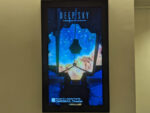
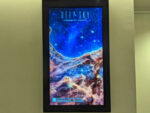
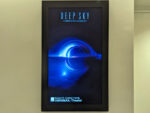
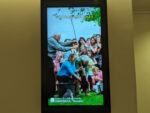
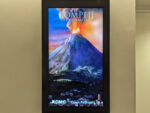
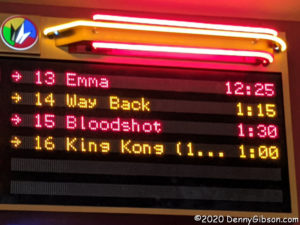

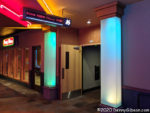

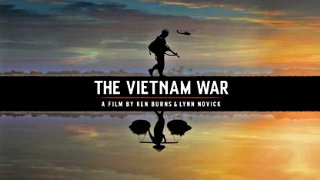
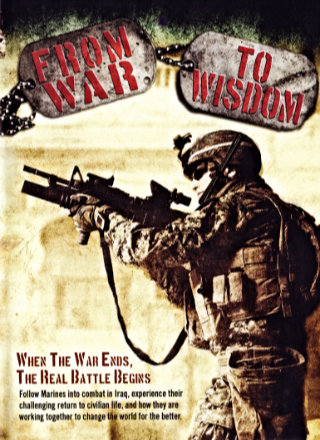 I might not even be aware of this movie’s existence if I didn’t know one of the directors. Maybe someone else will learn of it only because they know me. If so, that’s a good thing. And it’s also a good thing if someone learns of the movie by stumbling onto this blog post without knowing either of us. If either of those things happens and someone watches
I might not even be aware of this movie’s existence if I didn’t know one of the directors. Maybe someone else will learn of it only because they know me. If so, that’s a good thing. And it’s also a good thing if someone learns of the movie by stumbling onto this blog post without knowing either of us. If either of those things happens and someone watches 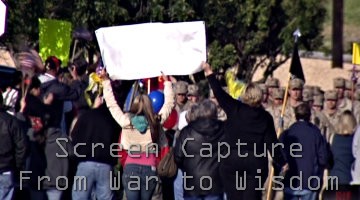 Creating a marker between the halves is a text only shot. In front of the shot we see returning soldiers marching between welcoming signs and banners then being dismissed to reunite with their families while veteran Hans Palmer describes the time as “the proudest I’ve ever felt in my life.” Following the text is a scene with Josh Hisle talking about needing a “place to decompress — every day.” He’s sitting outside his apartment waiting for everyone else in the complex — his “area” — to go to sleep. “It’s not insomnia,” he says. “It’s duty.”
Creating a marker between the halves is a text only shot. In front of the shot we see returning soldiers marching between welcoming signs and banners then being dismissed to reunite with their families while veteran Hans Palmer describes the time as “the proudest I’ve ever felt in my life.” Following the text is a scene with Josh Hisle talking about needing a “place to decompress — every day.” He’s sitting outside his apartment waiting for everyone else in the complex — his “area” — to go to sleep. “It’s not insomnia,” he says. “It’s duty.” There are many other examples of veterans helping veterans both in the film and out. They are bright spots and their successes are to be celebrated but they aren’t enough to make From War to Wisdom a feel good movie. It is, however, an encouraging movie and an informative one. Most of the veterans that appear in the film fought in either Afghanistan or Iraq. There is one notable exception. He’s a Vietnam vet who’s legal name is now Ragtime. He is a stained glass artist who teaches at Common Ground and started
There are many other examples of veterans helping veterans both in the film and out. They are bright spots and their successes are to be celebrated but they aren’t enough to make From War to Wisdom a feel good movie. It is, however, an encouraging movie and an informative one. Most of the veterans that appear in the film fought in either Afghanistan or Iraq. There is one notable exception. He’s a Vietnam vet who’s legal name is now Ragtime. He is a stained glass artist who teaches at Common Ground and started 